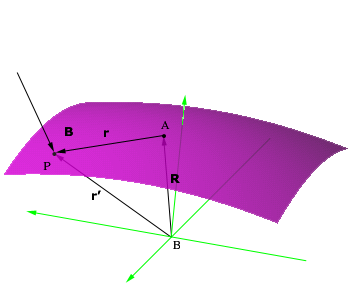Moment (physics)
|
|
- See also moment (mathematics) for a more abstract concept of moments that evolved from this concept of physics.
In physics, the moment of force (often just moment, though there are other quantities of that name such as moment of inertia) is a quantity that represents the magnitude of force applied to a rotational system at a distance from the axis of rotation. The concept of the moment arm, this characteristic distance, is key to the operation of the lever, pulley, gear, and most other simple machines capable of generating mechanical advantage.
| Contents |
Overview
In general, the moment M of a vector B is
- <math>\mathbf{M_A} = \mathbf{r} \times \mathbf{B} \,<math>
where
- r is the position where quantity B is applied.
If r is a vector relative to point A, then the moment is the "moment M with respect to the axis that goes through the point A", or simply "moment M around A". If A is the origin, one often omits A and says simply moment.
Parallel axis theorem
Since the moment is dependent on the given axis, the moment expression possess a common property when the observation axis is changed. If MA is the moment around A, then the moment around the axis that goes through a point B is
- <math>\mathbf{M_B} = \mathbf{M_A} + \mathbf{R} \times \mathbf{B} \,<math>
where
- R is the vector from point B to point A.
This expression is usually referred to as the parallel axis theorem. For cases when the moment is the sum of individual "submoments", such as in rigid body dynamics where each particle of the body contribute to a moment, the axis change is the sum of a macroscopic and microscopic quantity,
- <math>\mathbf{M_B} = \mathbf{R} \times \mathbf{B} + \sum_{i=0}{\mathbf{r_i} \times \mathbf{b_i}} \,<math>
where
- <math>\mathbf{B} = \sum_{i=0}{\mathbf{b_i}} \,<math>
or alternatively,
- <math>\mathbf{M_B} = \mathbf{R} \times \mathbf{B} + \mathbf{M_A} \,<math>
Related quantities
Some notable physical quantities arise from the application of moments:
- Angular momentum (L = Iω), which is typically the cause of rotational motion of a body.
- Moment of inertia (I = mω×r), which is analogous to mass in discussions of rotational motion.
- Torque (τ = rF), which is a force applied on a position of a body. When no net torque is applied, angular momentum is conserved.
History
The principle of moments is derived from Archimedes' discovery of the operating principle of the lever. In the lever one applies a force, in his day most often human muscle, to an arm, a beam of some sort. Archimedes noted that the amount of force applied to the object, the moment of force, is defined as M = rF, where F is the applied force, and r is the distance from the applied force to object.de:Moment (Physik) ja:モーメント pl:Moment sv:Moment vi:Mô men zh:力矩

